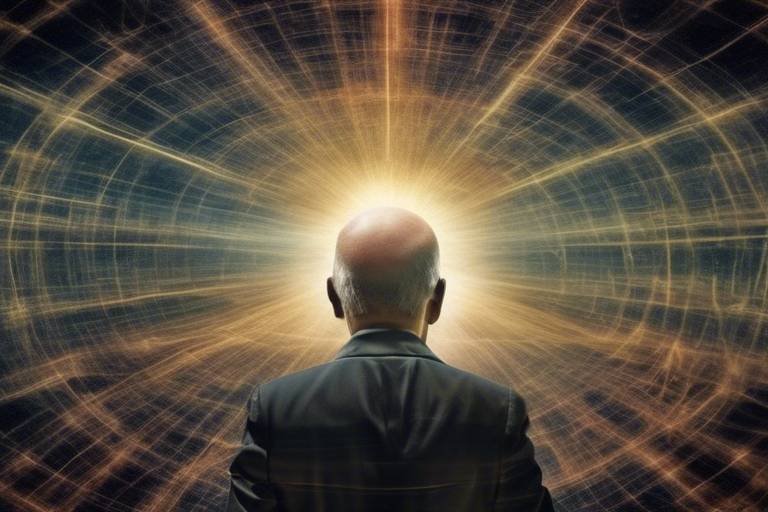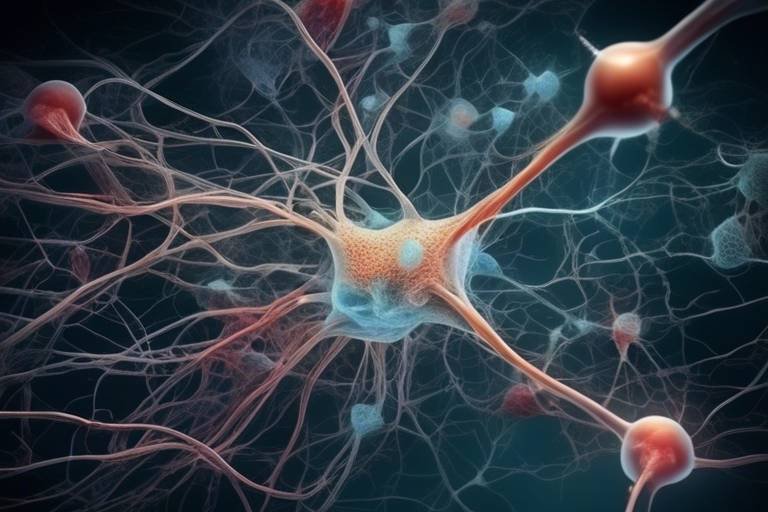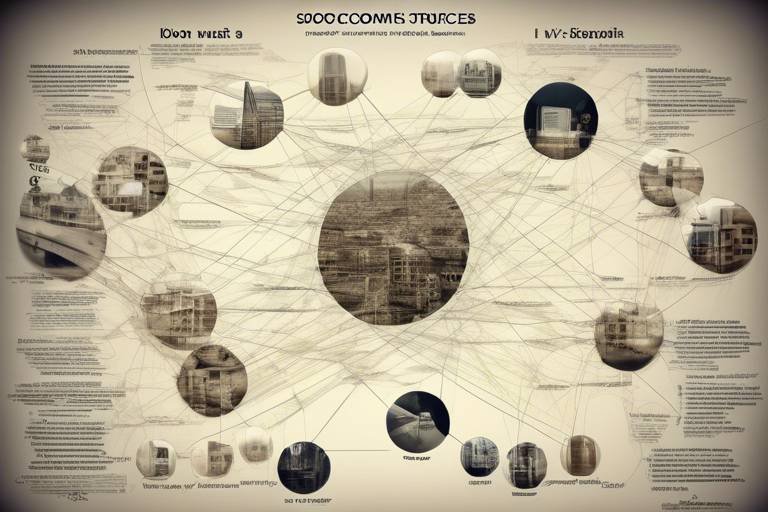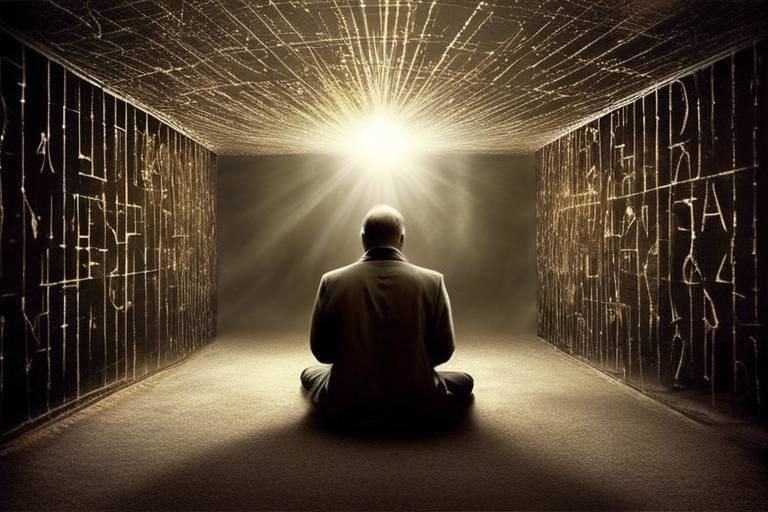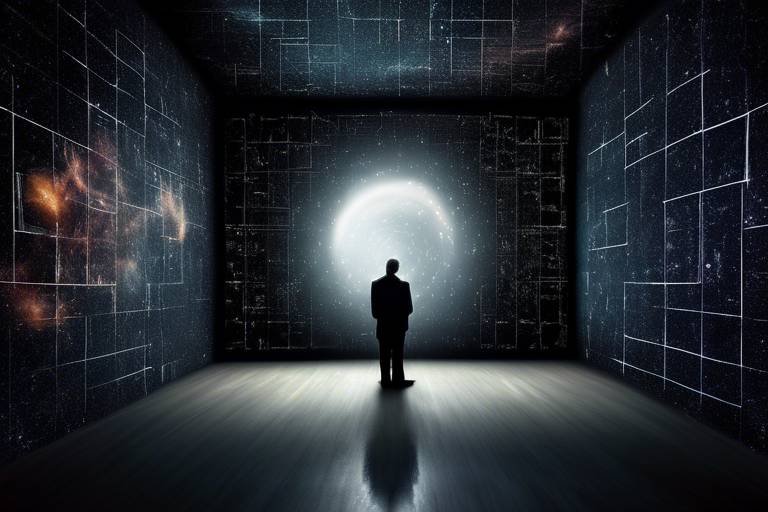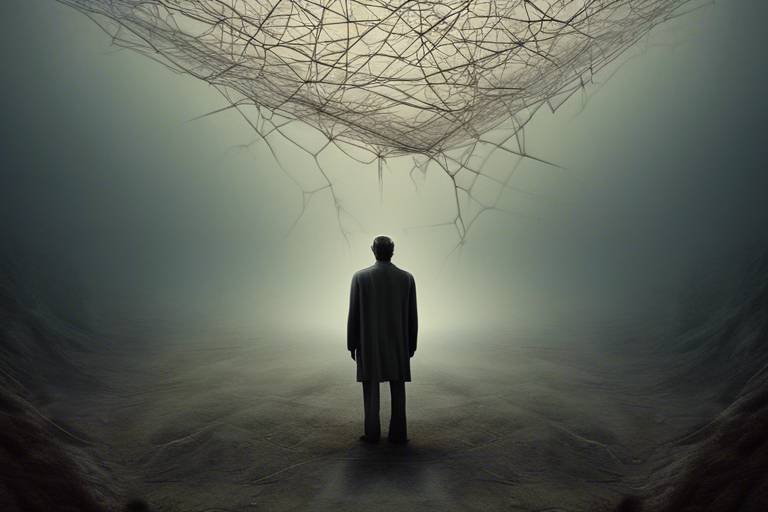Metaphysics and the Existence of Parallel Universes
Have you ever gazed up at the stars and wondered if there’s more to reality than what we perceive? The concept of parallel universes has fascinated thinkers for centuries, intertwining the realms of metaphysics, philosophy, and modern science. At its core, metaphysics seeks to understand the fundamental nature of reality, existence, and the universe itself. So, what happens when we apply these metaphysical inquiries to the idea of multiple universes? The implications can be both mind-bending and exhilarating!
Imagine a universe where every choice you make spawns a new reality, each diverging path creating a unique existence. This tantalizing notion isn’t just the stuff of science fiction; it’s a serious topic of discussion among scientists and philosophers alike. As we delve into the metaphysical theories surrounding parallel universes, we uncover a tapestry woven with threads of possibility, questioning not just what exists, but how we define existence.
In this exploration, we will navigate through the foundational concepts of metaphysics, examining how they frame our understanding of parallel universes. We will also encounter various philosophical perspectives that challenge and support the notion of multiple realities. Are these universes merely theoretical constructs, or could they hold tangible truths about our own existence? Buckle up, because the journey through the cosmos of thought is about to get exciting!
As we peel back the layers of these complex ideas, we will also look at the scientific advancements that lend weight to the theories of parallel universes. From quantum mechanics to cosmology, the universe may be far more intricate than we ever imagined. So, let’s embark on this intellectual adventure, exploring the profound questions that challenge our understanding of reality and existence itself!

The Foundations of Metaphysics
To truly grasp the concept of parallel universes, we must first dive into the intriguing realm of metaphysics. Metaphysics, at its core, is the branch of philosophy that seeks to answer the fundamental questions of existence. What is reality? What is being? These are not just academic inquiries; they are the bedrock upon which our understanding of the universe is built. Imagine metaphysics as the skeleton of a vast, intricate body of knowledge, where each bone represents a different concept or principle that supports our comprehension of the world around us.
One of the key principles of metaphysics is the distinction between ontology and epistemology. Ontology deals with the nature of being and what exists, while epistemology focuses on the nature and scope of knowledge. This distinction is crucial when considering parallel universes, as it forces us to ask not only whether these universes exist, but also how we can know anything about them. Are they real, or merely figments of our imagination? Just as a painter needs a palette of colors to create a masterpiece, philosophers use these concepts to paint a picture of reality that includes potential parallel worlds.
Moreover, metaphysics challenges us to think beyond the tangible. It invites us to explore the abstract, the invisible, and the unknown. For example, the idea of multiple realities can be likened to a vast library, where each book represents a different universe, each with its own unique story and set of rules. Just like a library, the concept of parallel universes suggests that there is an infinite number of narratives that could unfold, depending on the choices made at any given moment.
In the context of parallel universes, metaphysics also introduces us to the concept of modal realism. This theory suggests that all possible worlds are as real as the actual world we inhabit. Imagine standing at a crossroads, where each path represents a different decision you could make. According to modal realism, every decision you could have made exists in its own universe. This can be a mind-bending idea, but it opens up an entire universe of possibilities, quite literally!
As we navigate through these metaphysical waters, we must also consider the implications of our findings. If parallel universes exist, what does this mean for our understanding of free will, destiny, and the nature of existence itself? Are we mere puppets in a cosmic play, or do we have the power to shape our own realities? These questions are not just philosophical musings; they are vital to our understanding of life and our place within it.
In summary, the foundations of metaphysics provide us with the tools to explore the complex and often bewildering idea of parallel universes. By examining ontological and epistemological questions, as well as engaging with concepts like modal realism, we can begin to unravel the mysteries of existence. Just as a key opens a door to a new room, metaphysics unlocks our understanding of the many realities that may lie beyond our own.

Philosophical Perspectives on Parallel Universes
The debate surrounding the existence of parallel universes is not merely a scientific endeavor; it is deeply rooted in philosophical inquiry. Philosophers have long pondered the nature of reality, existence, and the implications of multiple universes. At its core, the question of whether parallel universes exist challenges our understanding of what it means to be real. Are these universes mere figments of our imagination, or do they hold tangible existence? This inquiry leads us to explore various philosophical frameworks that provide differing perspectives on the concept of parallel universes.
One prominent philosophical perspective is derived from the work of David Lewis, who introduced the idea of modal realism. According to Lewis, all possible worlds are as real as our own. In this view, parallel universes are not just hypothetical constructs; they are actual entities that exist in their own right. This perspective raises fascinating questions about the nature of existence and how we define reality. If every possible outcome occurs in its own universe, then the implications for personal identity and choice become profoundly complex. Are we merely one version of ourselves among countless others, each making different choices and living different lives?
Another significant philosophical framework comes from the realm of existentialism. Existentialists argue that the essence of existence is shaped by individual experiences and choices. In this light, the existence of parallel universes can be seen as a metaphor for the myriad paths our lives can take. Each decision we make creates a branching path, leading to different outcomes and experiences. This perspective encourages us to reflect on the weight of our choices, as each one could potentially lead to a different universe where the consequences of those choices unfold in unique ways.
Furthermore, the concept of multiverse theory in cosmology echoes philosophical inquiries into the nature of existence. Philosophers like Hugh Everett III, who formulated the Many-Worlds Interpretation, suggest that every quantum event spawns a new universe. This interpretation has profound implications for our understanding of fate and free will. If every possibility is realized, does that diminish the significance of our choices? Or does it enhance our understanding of the vastness of existence, where every decision creates a new reality, and we are but travelers across these infinite landscapes?
However, the philosophical exploration of parallel universes is not without its critiques. Some philosophers argue that the notion of an infinite number of universes leads to a form of nihilism, where nothing holds intrinsic value because every possibility is realized somewhere. This perspective raises the question: if every action and outcome exists somewhere, what does that mean for the significance of our current reality? Are we merely living in a bubble of experiences that are inconsequential in the grand scheme of the multiverse?
In summary, the philosophical perspectives on parallel universes invite us to challenge our understanding of reality and existence. They encourage us to consider the implications of our choices, the nature of our identity, and the vastness of the cosmos. As we delve deeper into these philosophical inquiries, we find ourselves grappling with fundamental questions about what it means to exist in a universe—or perhaps, a multiverse—filled with infinite possibilities.
- What is modal realism? Modal realism posits that all possible worlds are as real as our own, suggesting that parallel universes exist in their own right.
- How does existentialism relate to parallel universes? Existentialism emphasizes individual experiences and choices, viewing parallel universes as metaphors for the different paths our lives can take.
- What are the implications of the Many-Worlds Interpretation? This interpretation suggests that every quantum event leads to the creation of new universes, raising questions about free will and the significance of our choices.
- Can parallel universes lead to nihilism? Some critics argue that if every possibility exists, it could diminish the value of our current reality and experiences.

The Many-Worlds Interpretation
The Many-Worlds Interpretation (MWI) of quantum mechanics is a fascinating and mind-bending concept that suggests every possible outcome of a quantum event actually occurs, but in separate, branching universes. Imagine standing at a crossroads: each path you could take represents a different choice, leading to a different version of reality. In the realm of MWI, every decision we make creates a new universe where every alternative outcome exists simultaneously. This interpretation challenges our conventional understanding of reality and pushes the boundaries of metaphysical thought.
Developed by physicist Hugh Everett III in 1957, the Many-Worlds Interpretation emerged as a radical alternative to the traditional Copenhagen interpretation of quantum mechanics, which posits that particles exist in a state of probability until they are observed. Instead, MWI asserts that all possibilities are realized, leading to a vast multiverse where every conceivable scenario unfolds. This means that somewhere out there, in a parallel universe, you might be living a completely different life based on choices you didn’t make in this one. It’s like flipping a coin: while we see it land on heads or tails, MWI suggests that both outcomes occur, each in its own universe.
One of the most striking implications of the Many-Worlds Interpretation is its challenge to the notion of reality itself. If every possible outcome exists in its own universe, then our understanding of existence becomes profoundly complex. We must ask ourselves: what does it mean to be "real"? Is our universe just one of an infinite tapestry of realities, each equally valid? This philosophical inquiry leads us to consider the implications of our choices and the nature of existence itself. Are we merely players in a cosmic game where every decision spins off a new reality?
Critics of MWI argue that the interpretation raises more questions than it answers. For instance, how can we test the existence of these parallel universes? If every outcome occurs, does it mean that our universe is just one of many, and if so, what does that mean for our understanding of causality and free will? These questions spark intense debate among philosophers and scientists alike, as they grapple with the profound implications of a multiverse.
Despite the criticisms, there is a growing interest in MWI, especially as advancements in quantum physics continue to unfold. The interpretation has gained traction among physicists who are intrigued by the idea that quantum phenomena might be better explained through a multiverse framework. The MWI offers a coherent and elegant solution to some of the paradoxes presented by quantum mechanics, such as Schrödinger's cat, a thought experiment that illustrates how particles can exist in multiple states simultaneously until observed.
In summary, the Many-Worlds Interpretation of quantum mechanics invites us to reconsider our understanding of reality, existence, and the choices we make. It opens up a universe of possibilities, quite literally, and challenges us to explore the depths of metaphysical thought. As we delve deeper into this enigma, we may find that our universe is just one of many, each with its own unique story to tell.

Critiques of the Many-Worlds Interpretation
The Many-Worlds Interpretation (MWI) of quantum mechanics, while fascinating, has not escaped scrutiny. Critics argue that the theory raises more questions than it answers. One of the primary critiques is the challenge of ontological extravagance. Essentially, skeptics question whether it is reasonable to posit an infinite number of universes to explain quantum phenomena. This perspective suggests that MWI may be unnecessarily complex, leading to the principle known as Occam's Razor, which advocates for simplicity in scientific theories. Why multiply entities beyond necessity? Critics argue that simpler explanations might suffice to account for the observed quantum behaviors.
Furthermore, there’s the issue of empirical testability. Critics point out that if every possible outcome occurs in separate universes, then the MWI may be fundamentally untestable. In science, a theory must be testable to gain acceptance, yet the MWI seems to evade this criterion. How can we ever observe these parallel universes, or even gather evidence of their existence? This lack of empirical evidence raises eyebrows among scientists who prefer theories that can be observed and measured.
Another critique stems from the concept of consciousness and observation. The MWI suggests that every time a quantum event occurs, the universe branches into multiple realities. However, critics argue that this leads to a convoluted understanding of consciousness. If every possible outcome exists in a separate universe, then what happens to the observer's consciousness? Does it split as well? This notion can become quite perplexing, leading to philosophical dilemmas about the nature of self and experience.
Moreover, some scientists propose alternative interpretations that seem to offer more straightforward explanations for quantum phenomena. The Copenhagen Interpretation, for instance, posits that quantum particles exist in a state of probability until observed. This interpretation does not require a multitude of parallel universes, making it a more palatable option for many physicists. Critics of MWI often advocate for such interpretations, arguing that they provide a clearer understanding of quantum mechanics without the complications of infinite realities.
In conclusion, while the Many-Worlds Interpretation presents a captivating view of reality, it is not without its challenges. Critics highlight issues of ontological extravagance, empirical testability, and the complexities surrounding consciousness. As the debate continues, it is clear that the exploration of parallel universes will remain a hot topic in both scientific and philosophical circles.
- What is the Many-Worlds Interpretation? The Many-Worlds Interpretation is a theory in quantum mechanics suggesting that all possible outcomes of quantum events occur in separate, branching universes.
- Why do some scientists criticize the MWI? Critics argue that it is ontologically extravagant, untestable, and complicates our understanding of consciousness.
- What are some alternatives to the Many-Worlds Interpretation? Alternatives include the Copenhagen Interpretation, which posits that particles exist in a state of probability until measured.
- Can we ever observe parallel universes? Currently, there is no empirical evidence or method to observe parallel universes, making it a challenging area of study.

Supporting Evidence from Quantum Physics
The realm of quantum physics is often likened to a mysterious and enigmatic landscape, where the rules of classical physics seem to dissolve into a whirlpool of probabilities and uncertainties. One of the most captivating aspects of quantum mechanics is its ability to support the idea of parallel universes, particularly through the lens of the Many-Worlds Interpretation (MWI). This interpretation suggests that every quantum event results in a branching of universes, where all possible outcomes coexist in separate realities. Imagine a tree that splits into countless branches with each decision you make; this is a tangible way to visualize how our universe might operate at a quantum level.
Several key experiments in quantum physics lend credence to this theory. One of the most famous is the double-slit experiment, which demonstrates how particles can behave as both waves and particles. When particles are fired at a barrier with two slits, they create an interference pattern, suggesting they pass through both slits simultaneously. This phenomenon raises questions about the nature of reality and whether all potential outcomes are realized in their own distinct universe. If we consider each possible path the particle might take as a separate universe, it aligns perfectly with the MWI.
Another compelling piece of evidence comes from the phenomenon known as quantum entanglement. When two particles become entangled, the state of one instantaneously influences the state of the other, regardless of the distance separating them. This strange connection hints at a deeper level of reality where multiple universes may interact in ways we do not yet fully understand. It’s as if these entangled particles are communicating across the multiverse, further supporting the notion that our universe is just one thread in a vast tapestry of existence.
Moreover, the concept of superposition plays a crucial role in quantum mechanics. In superposition, particles exist in multiple states at once until they are observed. This idea can be interpreted as a metaphor for parallel universes; each state represents a different universe where a different outcome has occurred. Thus, when a quantum event takes place, it’s as if the universe splits into various realities, each containing a different version of events. The implications of this are profound, suggesting that every choice we make could spawn a new universe where an alternative choice was taken.
While these quantum phenomena provide fascinating insights, it’s essential to approach them with a critical mind. The connection between quantum mechanics and the existence of parallel universes remains largely theoretical and is still a subject of intense debate among physicists. Nevertheless, the evidence presented by experiments like the double-slit experiment and the principles of entanglement and superposition serve as a robust foundation for exploring the tantalizing possibility that we are part of a much larger multiverse.
In summary, quantum physics not only challenges our traditional notions of reality but also offers a framework to consider the existence of parallel universes. As we delve deeper into the quantum realm, we may find that the universe is far more complex and interconnected than we ever imagined, opening doors to new realms of understanding and exploration. The journey into the multiverse is just beginning, and who knows what astonishing discoveries await us on the other side?
- What is the Many-Worlds Interpretation? - It is a theory in quantum mechanics suggesting that all possible outcomes of quantum events occur in separate, branching universes.
- How does quantum entanglement relate to parallel universes? - Quantum entanglement suggests that particles can be connected in ways that transcend distance, hinting at a deeper reality that may involve multiple universes.
- What is the double-slit experiment? - It is a famous experiment that demonstrates the wave-particle duality of light and matter, providing evidence for the Many-Worlds Interpretation.
- Is there definitive proof of parallel universes? - Currently, the idea of parallel universes remains theoretical, with no definitive proof, but quantum physics provides compelling arguments in support of the concept.

Alternative Theories of Parallel Universes
When we dive into the concept of parallel universes, it becomes clear that the Many-Worlds Interpretation isn't the only game in town. There are several alternative theories that paint a fascinating picture of what could be lurking just beyond our own reality. One of the most intriguing concepts is string theory. This theory posits that the fundamental building blocks of the universe are not particles but rather tiny, vibrating strings. These strings can exist in multiple dimensions, which opens the door to the possibility that there are numerous universes, each with its own unique laws of physics. Imagine each string vibrating in a different way, giving rise to different realities—it's like a cosmic symphony where each note represents a different universe!
Another captivating idea comes from the realm of cosmology, specifically the inflationary multiverse theory. According to this theory, our universe underwent rapid expansion after the Big Bang, which could have led to the creation of countless other universes, each with its own distinct characteristics. In this scenario, some universes might be similar to ours, while others could be wildly different, perhaps even featuring alternate forms of matter and energy. It's as if our universe is just one bubble in a vast sea of cosmic bubbles, each floating in its own unique space.
Moreover, the concept of branes in string theory adds another layer of complexity to the discussion. In this framework, our universe could be a three-dimensional brane existing within a higher-dimensional space. Other branes could represent other universes, and collisions between these branes might create new universes or even lead to catastrophic events in our own. This idea can be likened to a grand cosmic dance, where the movements of these branes dictate the formation and fate of entire realities.
While these theories are certainly captivating, they also raise a multitude of questions. For instance, if there are infinite universes, what does that mean for the concept of choice and free will? Are our decisions merely one of countless possibilities played out across different realities? Such questions challenge our understanding of existence itself, pushing the boundaries of metaphysical thought.
In summary, the exploration of alternative theories of parallel universes not only expands our intellectual horizons but also invites us to ponder the very nature of reality. Each theory offers a unique lens through which we can examine our existence, and while we may not have all the answers, the journey of discovery is just as important as the destination. As we continue to explore these ideas, we may find that the universe is far more complex and wondrous than we ever imagined.
- What are parallel universes? Parallel universes are hypothetical self-contained universes that exist alongside our own, potentially with different laws of physics and realities.
- How does string theory relate to parallel universes? String theory suggests that the fundamental components of the universe are tiny strings, which can exist in multiple dimensions, leading to the possibility of multiple universes.
- What is the inflationary multiverse theory? This theory posits that our universe underwent rapid expansion after the Big Bang, creating numerous other universes with diverse characteristics.
- Can we ever prove the existence of parallel universes? Currently, the existence of parallel universes remains theoretical, and proving them poses significant scientific challenges.

The Role of Science in Understanding Parallel Universes
When we dive into the concept of parallel universes, science becomes our guiding light, illuminating the dark corners of metaphysical speculation. It's fascinating to think about how scientific inquiry has taken us from mere philosophical musings to a realm where we can actually test some of these mind-bending ideas. The intersection of physics and metaphysics opens up a treasure trove of questions about existence, reality, and the very fabric of the universe. So, how does science contribute to our understanding of these elusive alternate realities?
First and foremost, advancements in quantum physics have provided a framework for exploring the idea of parallel universes. The peculiar behavior of particles at the quantum level—where things can exist in multiple states simultaneously—suggests that our universe might not be the only one. This leads us to a crucial point: the Many-Worlds Interpretation of quantum mechanics. According to this interpretation, every time a quantum event occurs, the universe splits into different branches, each representing a different outcome. This means that an infinite number of universes coexist, each with its own unique version of reality.
However, the scientific journey doesn't stop there. Cosmology, the study of the universe's origin and evolution, also plays a pivotal role in our understanding of parallel universes. The multiverse theory proposes that what we perceive as our universe is just one of many within a vast "multiverse." This theory opens up a Pandora's box of possibilities, suggesting that there could be universes with different physical laws, constants, and even dimensions. Imagine a universe where gravity is weaker or where time flows differently—what would that look like? Such questions tantalize our imagination and challenge our understanding of existence.
Yet, the exploration of parallel universes isn't without its hurdles. Scientific inquiry is not just about asking questions; it's also about finding ways to answer them. The experimental challenges we face are significant. For instance, how do we even begin to measure or observe something that exists outside our own universe? Current technologies and methodologies are limited, and many scientists argue that the very nature of parallel universes makes them inherently unobservable. This leads to a critical discussion about the limitations of experimental methods in studying these abstract concepts.
Despite these challenges, scientists remain optimistic. Ongoing research in string theory and other advanced models provides new avenues for understanding the universe's structure. These theories suggest that our universe could be one of many, each vibrating at different frequencies. This idea not only enriches our understanding of physics but also invites us to reconsider what we know about reality itself. In essence, science acts as both a compass and a telescope, guiding us through the complexities of existence while also expanding our horizons.
In summary, the role of science in understanding parallel universes is multifaceted and ever-evolving. It challenges us to think beyond the limits of our own universe and consider the myriad possibilities that lie beyond our perception. As we continue to push the boundaries of scientific knowledge, we may find that the question of whether parallel universes exist is not just a philosophical debate but a scientific inquiry waiting to be explored.
- What are parallel universes? Parallel universes are hypothetical self-contained separate realities coexisting with our own universe.
- How does quantum physics relate to parallel universes? Quantum physics suggests that every possible outcome of a quantum event occurs in separate branching universes, leading to the Many-Worlds Interpretation.
- What is the multiverse theory? The multiverse theory proposes that our universe is just one of many universes, each potentially having different laws of physics.
- Why is it difficult to study parallel universes scientifically? The primary challenge lies in the inability to observe or measure other universes due to their hypothetical nature and the limitations of current technology.

Cosmology and the Multiverse Theory
Cosmology, the study of the universe's origin, evolution, and eventual fate, plays a pivotal role in our understanding of the multiverse theory. This theory posits that our universe is just one of an infinite number of universes, each with its own distinct laws of physics and realities. Imagine a vast ocean, where each wave represents a different universe, crashing into one another yet remaining entirely separate. This metaphor captures the essence of the multiverse: an expansive collection of realities that coexist beyond our perception.
At the heart of multiverse theory are several intriguing concepts that challenge our traditional views of existence. One such concept is the idea that different regions of space could be governed by different physical laws. For instance, in some universes, gravity might be stronger or weaker than in our own, leading to entirely different forms of matter and life. This notion invites us to ponder profound questions: What if there are universes where time flows differently? Or where the fundamental constants of nature are altered? The possibilities are as limitless as the cosmos itself!
To better understand the multiverse theory, it's essential to explore its roots in cosmological models. The Big Bang theory, which explains the rapid expansion of our universe from a singular point, provides a foundation for multiverse ideas. Some scientists propose that during the inflationary period of the Big Bang, different regions of space-time underwent varying degrees of expansion, resulting in "bubble universes." Each bubble could represent a separate universe, complete with its own unique characteristics. This leads us to the question: Are we merely a bubble in an infinite cosmic bath?
Moreover, cosmologists have identified several models that support the multiverse concept:
- Inflationary Multiverse: This model suggests that inflation, a rapid expansion of the universe, can create multiple bubble universes.
- String Theory: String theory proposes that tiny, vibrating strings are the fundamental building blocks of the universe, leading to a landscape of possible universes with varying dimensions.
- Quantum Multiverse: In this interpretation, every quantum event spawns a new universe, resulting in a branching tree of realities.
Each of these models brings its own flavor to the multiverse theory, enriching our understanding of reality. However, the multiverse concept is not without its criticisms. Some scientists argue that the idea is inherently untestable, raising questions about its validity as a scientific theory. After all, if these universes are beyond our reach, how can we ever gather evidence for their existence? This dilemma leads to a fascinating debate about the nature of scientific inquiry and the limits of human understanding.
In summary, cosmology and the multiverse theory invite us to rethink our place in the universe. As we explore these complex ideas, we are reminded of the vastness of existence and the potential for realities beyond our own. The multiverse theory not only expands the horizons of scientific exploration but also ignites our imagination, urging us to consider the profound implications of living in a cosmos filled with infinite possibilities.
- What is the multiverse theory? The multiverse theory suggests that our universe is one of many, each potentially having different physical laws and constants.
- How does cosmology relate to the multiverse? Cosmology studies the universe's origins and evolution, providing the groundwork for understanding the multiverse through models like the Big Bang and inflation.
- Are there any scientific proofs of parallel universes? Currently, there is no direct evidence for parallel universes, but various theories and models suggest their potential existence.

Experimental Challenges and Limitations
The quest to understand parallel universes is as thrilling as it is daunting. Scientists and philosophers alike grapple with the complexities of proving or disproving the existence of these alternate realities. One of the most significant hurdles is the experimental challenges that arise when attempting to observe phenomena associated with parallel universes. Unlike traditional physics, where experiments can often be conducted in controlled environments, the realm of parallel universes operates on principles that are, at best, theoretical. This leads us to question: how do we even begin to test something that may exist beyond our observable universe?
First and foremost, the limitations of our current technology pose a significant barrier. While advancements in quantum physics have provided some insights, the instruments we possess today may not be equipped to detect the subtle signs of parallel universes. For instance, consider the idea of a multiverse where every decision creates a new branch of reality. How can we measure the outcome of decisions made in other universes? The very essence of these realities may be beyond our reach, leaving us with a tantalizing mystery.
Furthermore, the theoretical nature of many models complicates matters. Theories such as string theory and the Many-Worlds Interpretation offer fascinating perspectives but often lack the empirical data needed to support them. While physicists can propose equations and models that suggest the existence of parallel universes, these ideas remain largely speculative without concrete experimental evidence. In this context, the scientific community often finds itself in a paradox: we need evidence to validate our theories, yet our theories are what we rely on to understand the evidence.
Additionally, the concept of observable reality plays a critical role in our limitations. The universe we inhabit is governed by physical laws that we can measure and observe. However, if parallel universes exist outside these laws, how can we ever hope to observe them? The idea that there could be realities that are completely disconnected from our own raises profound questions about the nature of existence itself. It’s like trying to find a shadow in a dark room; without light, the shadow remains elusive, no matter how hard you look.
To illustrate these challenges, let’s consider a few key areas where experimental limitations become particularly pronounced:
| Challenge | Description |
|---|---|
| Technological Limitations | Current instruments may not detect phenomena associated with parallel universes. |
| Theoretical Models | Many theories lack empirical data, making them speculative. |
| Observable Reality | Parallel universes may operate outside our physical laws, making them unobservable. |
In summary, while the concept of parallel universes is exhilarating, the path to understanding them is fraught with challenges. The limitations of our current experimental methods, coupled with the theoretical nature of many models, create a complex web of uncertainty. As we continue to explore the boundaries of physics and metaphysics, we must remain patient and open-minded, recognizing that the answers we seek may lie beyond the horizon of our current understanding.
- What are parallel universes? Parallel universes are hypothetical self-contained realities co-existing alongside our own universe, often explored in theoretical physics and metaphysics.
- How do scientists study parallel universes? Scientists study parallel universes through theoretical models and quantum mechanics, though empirical evidence remains elusive.
- What is the Many-Worlds Interpretation? The Many-Worlds Interpretation suggests that all possible outcomes of quantum events occur in separate, branching universes.
- Are there any experiments that support the existence of parallel universes? While some quantum experiments hint at the possibility of multiple realities, definitive experimental evidence is still lacking.
Frequently Asked Questions
- What are parallel universes?
Parallel universes, often referred to as alternate or multiple universes, are hypothetical self-contained realities that exist alongside our own universe. Imagine them as different branches on a tree, where each branch represents a unique universe with its own set of physical laws and histories.
- How does metaphysics relate to parallel universes?
Metaphysics is the branch of philosophy that explores the fundamental nature of reality, including concepts like existence and the universe. When we talk about parallel universes, metaphysics helps us question what it means for something to exist and how these multiple realities could interact with or differ from our own.
- What is the Many-Worlds Interpretation?
The Many-Worlds Interpretation is a theory in quantum mechanics that suggests every possible outcome of a quantum event actually occurs, resulting in a branching of universes. This means that every choice we make creates a new universe where a different outcome happens. It’s like flipping a coin; in one universe it lands heads, in another tails!
- Are there criticisms of the Many-Worlds Interpretation?
Yes, there are several critiques. Some argue that it’s not testable and thus cannot be proven or disproven scientifically. Others believe it leads to an overwhelming number of universes, which complicates our understanding of reality. Critics often propose alternative theories that might explain quantum phenomena without invoking multiple universes.
- What evidence supports the existence of parallel universes?
While direct evidence is still elusive, some experiments in quantum physics, like the double-slit experiment, hint at behaviors that could be explained by the Many-Worlds Interpretation. These experiments show that particles can exist in multiple states simultaneously, suggesting a deeper reality that might include parallel universes.
- What are some alternative theories to parallel universes?
Besides the Many-Worlds Interpretation, theories like string theory and the concept of a multiverse propose different models of existence. String theory suggests that fundamental particles are not point-like but rather tiny, vibrating strings, which could lead to multiple dimensions and universes. The multiverse theory posits that our universe is just one of many, each with its own unique properties.
- How does science contribute to our understanding of parallel universes?
Scientific inquiry plays a crucial role in exploring the existence of parallel universes. Advances in physics, particularly in cosmology and quantum mechanics, provide frameworks and models that help us speculate about these alternate realities. However, the experimental challenges in proving their existence remain significant.
- What are the experimental challenges in studying parallel universes?
Investigating parallel universes is fraught with challenges. One major hurdle is that we currently lack the technology to observe or interact with these alternate realities. Many theories remain speculative, and until we can develop methods to test these ideas, our understanding will be limited to philosophical discussions and theoretical models.




